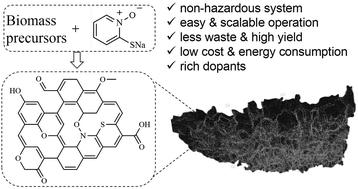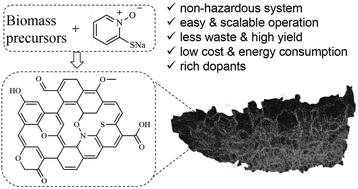用于水性锌离子电容器的吡啶硫酮钠盐活化生物质衍生碳的绿色合成
IF 9.2
1区 化学
Q1 CHEMISTRY, MULTIDISCIPLINARY
引用次数: 0
摘要
通过绿色工艺将生物质转化为掺杂活性碳(AC)被认为是实现现代能源储存应用的一条大有可为的途径。活性炭通常使用强碱合成,而强碱存在环境和操作风险。因此,有必要寻找替代性绿色活化试剂。在此,我们报告了一种多功能分子盐(吡硫鎓钠)作为活化试剂,用于制备具有大表面积、丰富掺杂物和多孔结构的经济可行的掺杂 AC。实验证明了碳的形成及其成分和孔隙结构的变化。随后,制备的交流电被制成锌离子电容器的阴极。我们通过分析电化学测量结果,将交流电的特性与其性能联系起来。同时,基于 SPHC 的最佳锌离子电容器在实际条件下可实现 20,000 次以上的高容量和出色的循环稳定性。此外,我们还发现交流电活性位点上的长期化学吸附/解吸会影响阴极结构,从而导致容量损失和储能机制的改变。总之,这项工作为合成掺杂交流电提供了另一种方案,可用作实用高性能 ZIC 的阴极材料。本文章由计算机程序翻译,如有差异,请以英文原文为准。


Green synthesis of sodium pyrithione salt-activated biomass-derived carbon for aqueous zinc-ion capacitors†
Conversion of biomass into doped activated carbons (ACs) via green processes is envisioned as a promising path toward modern energy storage applications. ACs are commonly synthesized using strong bases, which are associated with environment and operation risks. Thus, it is necessary to find alternative and green activation reagents. Herein, we report a multi-functional molecular salt (sodium pyrithione) as an activation reagent for the economically viable preparation of doped ACs with a large surface area, rich dopants, and porous structures. The formation of carbons and the variation in the composition and pore architecture were demonstrated. The prepared ACs were then fabricated into cathodes for a zinc-ion capacitor. We correlated the properties of ACs with their performance by analyzing electrochemical measurements. Meanwhile, the optimal SPHC-based ZIC delivered high capacity and excellent cycling stability over 20 000 cycles under practical conditions. Moreover, we found that long-term chemical adsorption/desorption on active sites of ACs influences the cathode structure and thus leads to a loss of capacity and changes in the energy storage mechanism. Overall, this work provides an alternative protocol for the synthesis of doped ACs, which can be used as cathodes materials for practical high-performance ZICs.
求助全文
通过发布文献求助,成功后即可免费获取论文全文。
去求助
来源期刊

Green Chemistry
化学-化学综合
CiteScore
16.10
自引率
7.10%
发文量
677
审稿时长
1.4 months
期刊介绍:
Green Chemistry is a journal that provides a unique forum for the publication of innovative research on the development of alternative green and sustainable technologies. The scope of Green Chemistry is based on the definition proposed by Anastas and Warner (Green Chemistry: Theory and Practice, P T Anastas and J C Warner, Oxford University Press, Oxford, 1998), which defines green chemistry as the utilisation of a set of principles that reduces or eliminates the use or generation of hazardous substances in the design, manufacture and application of chemical products. Green Chemistry aims to reduce the environmental impact of the chemical enterprise by developing a technology base that is inherently non-toxic to living things and the environment. The journal welcomes submissions on all aspects of research relating to this endeavor and publishes original and significant cutting-edge research that is likely to be of wide general appeal. For a work to be published, it must present a significant advance in green chemistry, including a comparison with existing methods and a demonstration of advantages over those methods.
 求助内容:
求助内容: 应助结果提醒方式:
应助结果提醒方式:


